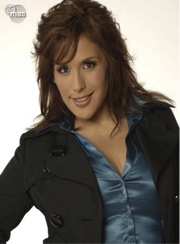Makeover in the telenovela La Fea más Bella: What is at stake in becoming beautiful?
No other Latin American telenovela has directly focused on the experience of beauty and ugliness with as much success as the Colombian telenovela “Yo soy Betty la Fea” (1999) and its further adaptations in other countries. In this discussion, however, I will concentrate on the Mexican version of this telenovela “La Fea más Bella” (2006), instead of the Columbian original not only because it was recognised as the 2007 best telenovela 1 but more so because its usefulness to explore the links between beauty, body and race. In this report, I address that “La Fea más Bella” represents these three concepts through Lety’s (the protagonist) experiences of a makeover, by utilizing data from the telenovela as well as establishing links with academic literature. I am interested in addressing how Lety transitions from a perceived “ugly duckling” to a supposedly “beautiful woman”. In other words, what changes does she make in order to become beautiful? What happens to the image of the woman before the transition? This transition is evident in the video clip, 2 the before and after images, and in segments of the show’s theme song lyrics 3 I provide and will explore below.
Although there may be several things Lety changes in her appearance, I will focus on the glasses, braid, and clothing Lety wears that are subject to change in her transition into a beautiful woman. These changes are evident in the images and video clip and are referred to in the show’s theme song. What is interesting is that these changes are seen as positive since they uncover her ‘real’ beauty that has been hiding all along. Because these markers stand out, and to a certain extent represent ugliness, I explore these alongside the experiences of race, body, and beauty when relevant.
In the theme song lyrics, 4 the song tells Lety that beneath her glasses there is something hidden. It is implied that Lety, who is seen as ugly by herself and others, there is someone who is actually beautiful but hidden. Yet, how is it that someone who is beautiful on the inside does not reflect that on the outside? When juxtaposing the images provided (see above) we see that although Lety can be beautiful wearing glasses, these are different from the ones she wore before. It is important that the telenovela allows the character to be pretty whether she wears them or not, but it is also significant that the ones she wears now make her more beautiful than the previous ones. In the video, 5 it is argued that it is something good to wear things that make you look attractive, which would make it something bad to wear things that make you look unattractive such as the previous ones she wore. By allowing this binary, the telenovela reinforces ideas about beauty that disadvantage people who do not change their appearance, when in actuality they should not have to. It also shows the dependence on the other to decide what is and what is not beautiful. For Leti, this meant that she was told what looked good and what did not which affected her emotionally.
In ‘Shame before Others’, Sara Ahmed (2004) reflects on idealization “which creates the effect of an ideal, is contingent because it is dependent on the values that are ‘given to’ subjects through their encounters with others.” (2004: 106). Thus, in terms of the idealization of beauty, there is the ‘other’ which influences how people perceive themselves, which is the case for Lety. Although the glasses do not have much to say about race and body, they do have something to say about beauty because beauty can be uncovered in certain ways, and one of those ways is by wearing ‘flattering’ glasses or things that flatter someone in general.
It is clear in the images that the braid hairstyle is something that undergoes a change since the new Lety is someone who has her hair undone. Because the post-makeover person is someone who looks naturally beautiful, 6 and because the image of that person no longer includes the braid, the braid is seen as something ugly or unflattering. But why would a braid shape a face in an unattractive manner? Is there anything objective about this, or are there elements of racism that can be teased out? Although the braid is not something that is explicitly mentioned as a change or as something covering up beauty, I argue that it is significant in exploring its role in a Latin American context where braids can be seen as symbols of indigenousness. An example of this can be found in the article by Rick López (2002), which is about the India Bonita Contest that took place in 1921 in Mexico. According to him, there were certain characteristics that marked indianness. Among these characteristics, braids were defining features. (López, 2002: 303). Thus, it can be argued that the braid in this telenovela is significant especially because it is something that is attributed to the Lety before the makeover. In other words, the braid was something that made Lety ugly and because the braid is related to notions of indigenousness or indianness, it is relevant when discussing racism.
Racism in Latin America can be a tricky subject to explain since even contemporary scholars make contradicting arguments on its existence and its effects. Peter Wade (2009) in Race and Sex in Latin America asserts as a fact that “race mixture creates a large category of mestizos, whose racial identity is shifting and fluid, is both evidence of racial democracy…and a location of racism (mestizo national identities privilege whiteness and marginalize…indigenousness” (2009: 158). In his argument, I am particularly interested in thinking of indigenousness, which is an ethnic category, as a location for racism. Thinking of the marginalization of Indians through mestizaje in this manner allows us to see why the braid, an Indian symbol, would be significant when thinking of racism. Perhaps Lety, through her braid, was conceived as someone ugly due to the connection this characteristic has to an ethnicity that is marginalized and thus given less value.
Nevertheless, there have been attempts to see the indigenous population in Latin America with a less perceived racist attitude. An example of this can be found in Mexico, which is the country the telenovela is based in (see footnote 1 above). According to Mónica Moreno Figueroa (2010), Mexicans or those who identify as such “have learned to see and praise Indigena peoples as an essential and vital part of the national culture…but they do not seem to have any desire to ‘look’ like them” (2010: 393). Perhaps then, this lack of desire is something that plays into the reasoning behind the change in the braid. Because Lety attained real beauty 7 and because this achievement involved letting go of the braid as a past symbol for ugliness, it could be argued that Lety was transformed into someone who could represent mestizaje by changing her features so that the indigenous characteristic could be out of the picture. This being said, racism then, can go beyond prejudices based on skin color. These can also be features or characteristics that are deemed better or worse than others. By making the braid a symbol of ugliness, the telenovela is representing racism or a form of racism by giving a negative value to the presence of a braid.
Besides the braid, I have mentioned I pay attention to the clothing Lety wears. In the images above it is evident that in the first image, when Lety is still seen as ‘ugly’ is wearing clothes that are more closed off and cover more skin than the clothing she wears once she is ‘beautiful’. Although the ‘beautiful’ Lety does not wear clothes that appear too revealing or show off too much skin, they do differ from the previous look she had. The theme song (see footnote 4 above) says that Lety should show the world how pretty she is. I wonder if by showing more skin, she is able to uncover an aspect of beauty that was hidden previously by her conservative looking clothing? However, how much skin is enough can be revealed before it is seen as too much? How is it that the body experiences notions of beauty and race?
As for beauty, Lety states that she likes who she is now ‘on the inside and outside’ and feels comfortable with that image (see footnote 7 above). The fact that she likes her appearance now and does not like how she looked before, says something about the way she looked before that was not experienced by the body as something good. The body can be covered, uncovered, and changed in many ways. I focus however, on the clothing that is put on the body because it represents certain notions about race and beauty that are linked.
A term that I would like to use to talk about body and race is borrowed from Sarah Ahmed (2002). She mentions ‘racialized bodies’ which implies that “we cannot understand the production of race without reference to embodiment…these processes involve the marking out of bodies as the site of racialization itself” (Ahmed, 2002: 46). Thus, if bodies can be sites of racialization, is there a racialization in the clothing Lety wears?
In the Ecuadorian beauty pageants, Mark Rogers (2003) contrasts the clothing worn by the indigenous pageants and that worn by the white ones. “A larger portion of indigenous pageants is devoted to presentation in traditional dress, whereas white pageants tend to foreground a focus on contemporary fashion, poise and style” (Rogers 348). Already, there is a difference in the style of clothing symbolic of the ethnicity of the girls in the pageants but also symbolic of the way it can make bodies feel. The clothes Lety wears could be seen as more traditional when compared to the clothes she is wearing after her makeover. Thus, it does not come as a surprise that Lety is seen as more elegant and happy with her makeover because it is something accepted by others as better looking. The way that the body is covered and the way that it is done up show how race and beauty are interlinked, which for Lety means having a different aesthetic that appears more white and less indigenous.
In conclusion, according to Yeidi M. Rivero (2010) in the article ‘The Performance and Reception of Televisual “Ugliness” in Yo soy Betty La Fea’, Betty, the Colombian version of Leti, is a “transnational success” and “is a product of globalization wherein the flow of audiovisual images transcends the local realm of resignification, creating de-contextualized cultural and political histories…”(2010: 65). Because of the globalized context the telenovela is positioned in, it would be interesting for further research to look at other ways in which ugliness is constructed and represented in places with different ideas about beauty, race, and body. In this analysis of key themes in the telenovela, through multiple connections across the data provided, I have shown that beauty matters and it is something that can be assessed by looking at media representations of what is beautiful and ugly.
Critical Report Bibliography
Ahmed, S. (2002) ‘Racialized Bodies’ in Real Bodies: A Sociological Introduction. New York: Palgrave
Ahmed, S. (2004) ‘Shame Before Others’ in The Cultural Politics of Emotion. Edinburgh: Edinburgh University Press.
Moreno Figueroa, M.G. (2010) ‘Distributed intensities: Whiteness, mestizaje, and the logics of Mexican racism’, Ethnicities, 10, 3: 387-401.
López, R.A. (2002) ‘ The India Bonita Contest of 1921 and the Ethnicization of Mexican National Culture’, Hispanic American Historical Review, 82, 2: 291-328.
Rivero, Y.M. (2010) ‘The Performance and Reception of Televisual “Ugliness” in Yo soy Betty la fea’, Feminist Media Studies, 3, 1: 65-81.
Rogers, M. (2003) ‘Spectacular Bodies: Folklorization and the Politics of Identity in Ecuadoran Beauty Pageants’ in Perspectives on Las Américas: A Reader in Culture, History, and Representation. UK: Blackwell Publishers Ltd.
Wade, P. (2009) ‘The Political Economy of Race and Sex in Contemporary Latin America’ in Race and Sex in Latin America. New York: Pluto Press.
Data Bibliography
Bacilos, J&M (2006) La Fea Más Bella Soundtrack found in http://www.youtube.com/watch?v=X6fzcLavd8s. Uploaded on YouTube 2011 by Katakota14, Accessed May 20th 2012
‘La Fea Más Bella’ Wikipedia http://en.wikipedia.org/wiki/La_Fea_Más_Bella. Accessed May 10th 2012. .
Fotogalería de telenovelas. esmas.com. http://www.esmas.com/lafeamasbella/fotogalerias. Accessed May 20th 2012.
Redacción. ‘Leticia Padilla Solís’, esmas.com. http://www.esmas.com/lafeamasbella/perfiles/505477.html. Accessed May 20th 2012.
Vicky_arg. Lyrics of ‘La Fea Más Bella’ telenovela theme song http://www.musica.com/letras.asp?letra=846870. Accessed May 1st 2012.
‘Obramaestra de Luigi Lombardi’. Uploaded 2007 by yoteamoLuigi. http://www.youtube.com/watch?v=76E4agxrCF4. Accessed May 21st 2012.
Acknowledgements
I would like to acknowledge Professor Figueroa for helping me think throughout the introduction and for her ideas on the relevance of race, body, and beauty.
Footnotes
- Telenovela Show Description
Website: http://en.wikipedia.org/wiki/La_Fea_Más_Bella
“La Fea Más Bella (“The Most Beautiful Ugly Girl”) is a Mexican telenovela produced by Televisa (in 2006). It is the second Mexican version of the popular Colombian telenovela: Betty la fea (which aired in 1999). La Fea más Bella stars popular actress/singer/comedian Angélica Vale and actor/singer Jaime Camil…”
…
“La Fea Más Bella was the number one Univision TV program according to 2006 Nielsen ratings often beating programs from The CW and MyNetworkTV. The finale was one of the most-watched Spanish programs in US history, drawing an average audience of 7.4 million viewers, according to Nielsen Media Research*. By comparison, the first season finale of ABC’s Ugly Betty drew approximately 2.5 million viewers. La Fea Más Bella also won the TV y Novelas award for best telenovela of the year (2007). In 2009 it was dubbed into Arabic and aired on MTV Lebanon as Letty instead of La Fea Más Bella.
*Information about the ratings was not found on Nielsen Media Research. It is possible that these results are no longer online Another website citing Nielsen Media Research for the telenovela’s ratings is: http://www.usatoday.com/life/television/news/2007-06-27-univision_N.htm. ↩
- Video: ‘Obra maestra de Luigi Lombardi’:
http://www.youtube.com/watch?v=76E4agxrCF4.
The video from the link above is a combination of scenes from the telenovela La Fea más Bella that showcase the final transformation of Lety into her most visibly beautiful self. It was edited by user yoteamoLuigiand uploaded on youtube.com on February 25, 2007. ↩
- Song: ‘La fea más Bella’
Song can be heard in the following link:
http://www.youtube.com/watch?v=X6fzcLavd8s
Artist: Margarita and Jorge of Bacilos
Uploaded by user: katakota14 on May 7, 2011 ↩
- Lyrics & Translation of ‘La Fea más Bella’ song
Spanish lyrics: http://www.musica.com/letras.asp?letra=846870
Detrás de tus gafas / Sé que hay algo más / Hay una mirada / Que me hace pensar / eres una estrella a punto de brillar / Le escondes al mundo lo que puedes dar
Pero te sientes tan fea / Y no te das una oportunidad / Deja que se vea, no escondas lo linda que eres de verdad / te sientes tan fea / Que sólo en tus sueños / te atreves a amar
Ya no lo pienses mas y deja de soñar / Mejor abre la puerta de la felicidad / Ya no lo pienses mas decídete a volar / Eres la fea más bella / Y no te has dado cuenta / Que cada día te quiero más
Todo el mundo es bueno para criticar / En la superficie todo es ideal / Pero poca gente es como tú / inteligente, / Especial y diferente a las demás
Letra añadida por vicky_arg en musica.com
Artist: Bacilos
Translation
Underneath your glasses / I know there is something more / There is a look / That makes me think / You are a star about to shine / You hide to the world what you can give to it
But you feel so ugly / And you do not give yourself a chance / Let it show, do not hide how pretty you truly are / You feel so ugly / That only in your dreams / you dare to love
Do not think about it longer and stop dreaming / Instead, open the door of happiness / Do not think about it longer, choose to fly / You are the prettiest ugly girl / And you have not discovered it / That every day I like/love you more
The entire world is good at criticizing / In the surface everything is ideal / But few people like you is intelligent / Special and different from the rest
English translation: Aseneth Garza ↩
- Minutes: 6:10-6:18
Luigi: “Los escogí (los lentes) pensando en las características de tu rostro para que luzcas preciosa por que siempre es bueno ponernos algo que nos haga lucir bellos y guapos.”
Translation:
“I chose them (the glasses) while thinking about your facial characteristics so that you look precious because it is always good to put on something that makes us look beautiful and attractive.” http://www.youtube.com/watch?v=76E4agxrCF4 ↩
- Minutes: 1:18-1:35
Luigi: “Por fin mi obra maestra, la perfecta recreación de la belleza natural, ahora si Luigi Lombardi crea el rostro de la fea más bella.”
Translation:
“At last, my masterpiece, the perfect recreation of natural beauty, now Luigi Lombardi creates the face of the most beautiful ugly girl.” http://www.youtube.com/watch?v=76E4agxrCF4 ↩
- Minutes: 4:30-4:58
Lety: “Quiero ser así para siempre, así me siento bien conmigo misma por dentro y por fuera. Estoy de acuerdo con lo que soy y con lo que siento porque comprendí que todos podemos alcanzar la belleza.”
Translation:
“I want to be like this forever, like this, I feel good with myself on the inside and outside. I am in agreement with what I am and with what I feel because I came to understand that all of us can reach/attain beauty.” http://www.youtube.com/watch?v=76E4agxrCF4 ↩





